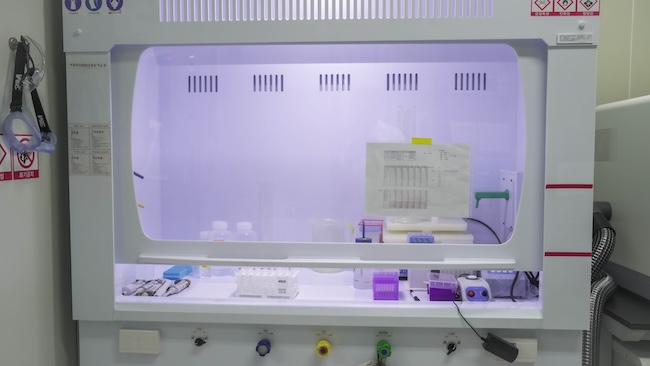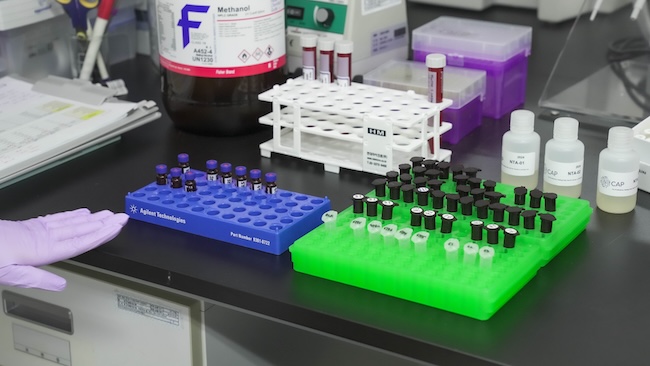
E-cigarette liquids may contain various substances without proper safety verification. (Image courtesy of the Korea Disease Control and Prevention Agency)
CHEONGJU, May 10 (Korea Bizwire) – At the smoking hazard laboratory in Osong, a city in North Chungcheong Province, researchers have been meticulously analyzing the liquid contents of commercially available e-cigarettes using advanced equipment, according to officials who gave a tour to reporters on May 8.
The intensive analysis stems from concerns that e-cigarette liquids may contain various substances without proper safety verification. The number of ingredients can vary as widely as the array of vaping products on the market. Identifying these components and assessing potential hazards is a critical first step in informing tobacco regulation policies.
Established in 2015, the laboratory examines the harmful effects of not only traditional combustible cigarettes but also emerging tobacco products like e-cigarettes and heat-not-burn devices through rigorous experimentation. The research data serves as a foundation for further studies and informs regulatory policymaking.
The facility features dedicated spaces for analyzing tobacco ingredients, detecting heavy metal components, and conducting cell-level experiments to evaluate health risks and disease susceptibility based on smoking patterns and habits.

The laboratory examines the harmful effects of not only traditional combustible cigarettes but also emerging tobacco products like e-cigarettes and heat-not-burn devices through rigorous experimentation. (Image courtesy of the Korea Disease Control and Prevention Agency)
“To regulate tobacco products, we need scientific evidence of the harmful effects on human health from exposure,” explained Min Seon-yeo, from the Korea Disease Control and Prevention Agency (KDCA). “The smoking hazard laboratory is recognized by the World Health Organization (WHO) as a facility that generates this essential data.”
The KDCA also presented biomarker test results that measure the concentration of harmful tobacco-derived substances in the body and assess disease risk for non-smokers, former smokers, and current smokers using urine samples. Biomarkers are indicators that can detect changes within the body using proteins, deoxyribonucleic acid (DNA), ribonucleic acid (RNA), and metabolites.
The tests revealed that the concentration of tobacco-derived harmful substances in non-smokers was lower than the minimum standard level (5ng/mL) used as a reference. Nicotine was undetected at 0ng/mL, while nornicotine and cotinine were found at 0.07ng/mL and 0.06ng/mL, respectively, in non-smokers.
In contrast, for smokers (consuming two packs per day), nicotine levels reached 22,771.05ng/mL, nornicotine 131.21ng/mL, and cotinine 4,743.10ng/mL, indicating a higher risk of lung cancer, cardiovascular disease, and other health issues.
For former smokers (who quit after 20 years and have been smoke-free for 12 years), the concentration of harmful tobacco-derived substances was similar to non-smokers. However, the analysis suggested that resuming smoking could increase their disease risk.
Recently, the laboratory has focused particular attention on the potential harms of e-cigarettes.
Among e-cigarettes, the liquid-based variety, increasingly popular among youth, involves inhaling vaporized nicotine solution mixed with diluents (such as propylene glycol and vegetable glycerin) and additives.
Tobacco companies have been targeting young people and adolescents with e-cigarettes, aiming to shed the negative image associated with traditional cigarettes. They employ appealing designs and flavors that appeal to younger demographics, offering a smoking experience devoid of the typical unsavory perception of cigarettes – a strategy to increase consumption among this audience.
Exploiting a loophole in the Tobacco Business Act, which only recognizes tobacco products derived from tobacco leaves, tobacco companies are selling products containing synthetic nicotine made from chemical compounds. British American Tobacco (BAT) Group is considering launching synthetic nicotine-based e-cigarette liquids in South Korea.
Lim Min Kyung, a professor at Inha University College of Medicine, highlighted the risk of e-cigarettes, saying, “While tobacco companies claim their new products are less harmful and aid in quitting smoking, experiments and statistics have proven otherwise. We must not forget that any product containing nicotine is considered a tobacco product.”
Lina Jang (linajang@koreabizwire.com)






